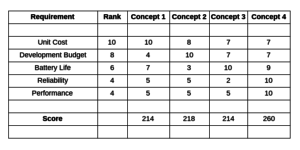Few would disagree that the iPod saved Apple from bankruptcy, but it was not just about the idea of a digital music player. There were at least 20 other digital music players on the market long before Apple started the project. Apple understood at a profound level that the requirement of “easy-loading songs” was essential, and they developed the concept of iTunes as a result of that understanding. We all know the results. Imagine if they had said, “We don’t need to worry about conceptual design. We know what we need already—we need to focus on getting it to work.” If the mission was singularly focused on getting a prototype to “work”, then Apple and the iPod would both be on the waste heap of yet another failed startup/product just like all the other digital music players/startups on the market at that time. Apple’s Conceptual Design for the iPod is mainly responsible for saving what would eventually become the most valuable company in the world.
If only all startups were as focused on Conceptual Design. Too often they focus on just getting a prototype, or getting it to work, long before any ideas about the Conceptual Design have been considered. This is unfortunate as excellent Conceptual Design is not all that complex and can be mastered with basic processes and some simple rules.
Conceptual Design sets 90% of the development cost, unit cost, performance, usability, number of fires you will have down the road, etc. Ninety percent of the success of a product is determined in the Conceptual Design phase – not in the detail design phase. It is the most leveraged part of the development processes. Get this wrong and everything after can be a colossal waste of time and money—something small companies can rarely afford to do.
Conceptual Design is more than just block diagrams and flowcharts. Conceptual Design is about developing a deep understanding of the requirements and comparing and contrasting different concepts for achieving these requirements in order to determine which concept will best meet the requirements. Having a good process for conducting a Conceptual Design will significantly improve the outcome. The process we recommend to our clients is as follows:
- Rank all the requirements (you did write a Requirements Document, if not, request our RD template). First, decide which of the requirements are “defining requirements”; that is, requirements that if they exceed the specified requirement then the result will be a better product. Take these defining requirements and rank them. For example, if there are 10 defining requirements, the most important one ranks as a 10. For each of the other defining requirements, decide how important it is to exceed the specified requirement relative to the number 10 requirement. A “5” means it is only half as important as the number 10 requirements. In the iPod case, the ability to quickly load songs was a very high ranking requirement.
- Now generate at least three different concepts for achieving the requirements. If you can not think of three, then keep thinking, or get someone to help. Do not accept that there is only one way to do anything.
- Now create a spreadsheet (or download it here) with the defining requirements down the side and the concepts you developed on the top.
- There will be a box for each intersection of a concept and a ranking requirement.
- Score each box on how well that concept will meet that requirement.
- Multiply the rank by the score and add them up.
Your sheet should look something like the table below.

This will take a little time to set up and to get everyone to understand, but it will be well worth the effort. The magic of this process is that it focuses the team on debating one requirement and one concept at a time. Is this requirement more critical than this other one? Will this concept be better than this other one in exceeding this requirement. Too often, teams get to overwhelmed and confused because they try to talk about everything at once, or miss important aspects of certain concepts because they are too focused on how well a concept will perform on some other requirement. Focusing on one box at a time brings clarity and objectivity to the conversation and decision making.
Here are a few other things to keep in mind when doing Conceptual Designs:
- Its a team sport: Conceptual Design is a group activity. To make good decisions, and to truly develop innovative products, you need input from many different areas: marketing, sales, production, operations, engineer, etc.
- Make sure your requirements are validated: A conceptual design can only be as good as the requirements document is. Are you sure the requirements are complete and have some form of market validation?
- Beware the technical expert: Nothing wrong with having a technical expert (in-depth knowledge, but not very broad) as part of the team; however, most of the team should be people with much board knowledge, not necessarily profound (sometimes called “T” people).
- Guard against NIH (Not Invented Here) Syndrome. Use an excellent facilitator who has the skill to uncovering decision bias.
- Avoid Groupthink. Bring in outsiders at crucial decision moments to mix up the thinking.
A product is only going to be as good as its Conceptual Design, no matter how well the detail design is accomplished. Using a proven methodology for conducting a Conceptual Design is a good start – especially for small companies and startups.



0 Comments